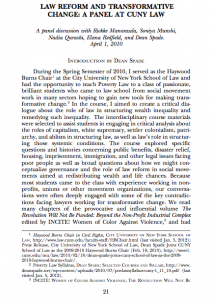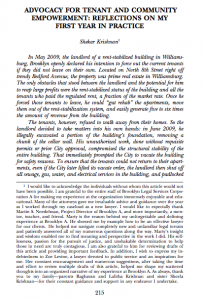Articles
The Penile Code: The Gendered Nature of the Language of Law
Matthew A. Ritter, Professor of Law, California Western School of Law
Written language has contributed to patriarchy by allowing men to monopolize writing – including law, as law is almost universally in written language – and thereby place themselves in the position of authority intended for the law itself, by defining rights and liberty in terms of male values, and by manipulating language so that the roles of men as subjects (in the grammatical sense of the word) and women as objects are reinforced as constantly as people speak, write and read. Working toward equality will require women to not only write, but to write as women, so that the monopoly is broken and the power of authorship is shared. Men must write as men rather than as abstract authors, so as to be under the law and equal with women, rather than equal to the law and above women.
Beach Erosion and Hurricane Protection in the Second Circuit: The Statute of Limitations as a Government Nemesis
Barbara Affedlt, J.D., City University of New York School of Law, 1997
A critique of statute of limitations rulings by the Second Circuit in regard to claims against the federal government for beach erosion damages in Long Island. The author contends that permissive interpretation of accrual and tolling standards will lead to excessive and expensive litigation, and discourage the government from undertaking projects that will protect the environment and shore property. The author proposes an accrual standard more akin to that of medical malpractice.
(REACT): Remote Electronically Activated Technology Stun Belt
Kevin C. Pyle, an illustrator and comix artist whose work has appeared in The New Yorker, the New York Times, and The Village Voice
An artistic piece about “electronic restraint belts,” devices that are placed on some prisoners for travel to court or other locations outside of correctional facilities. A remote control, carried by a correctional officer or marshal, is used to administer an electrical impulse to torso muscles that renders the wearer immobile, similar to a TASER, if the prisoner attempts an attack or escape. The piece juxtaposes the banal advisory document given to prisoners who are to be placed in the belts with a depiction of the pain and domination the belts inflict.
The Current Scope of the Public Safety Exception to Miranda Under New York v. Quarles
Alan Raphael, Professor of Law, Loyola University Chicago School of Law
A review of case law interpreting New York v. Quarles, 467 U.S. 649 (1984). This ruling permits admission of defendant responses to police questioning without a Miranda warning if the question is in regard to an imminent threat to public safety. The defendant, accused of raping a woman at gunpoint, was captured in a supermarket after a brief chase and found to be wearing an empty gun holster. Officers asked where the gun was and the defendant directed them to it. The author submits that many subsequent rulings have exceeded the narrow scope intended by the Supreme Court for such questioning by admitting statements obtained in situations with doubtful threats to public safety.
Note
What Justice Requires: A Case of Ineffective Assistance of Counsel
Mary Ross, J.D. Candidate, City University of New York School of Law, 1998
A piece on the responsibilities of defense attorneys and features of successful ineffective assistance of counsel appeal. The topic is presented through the lens of a successful effort to overturn a murder conviction on ineffective assistance of counsel grounds.


